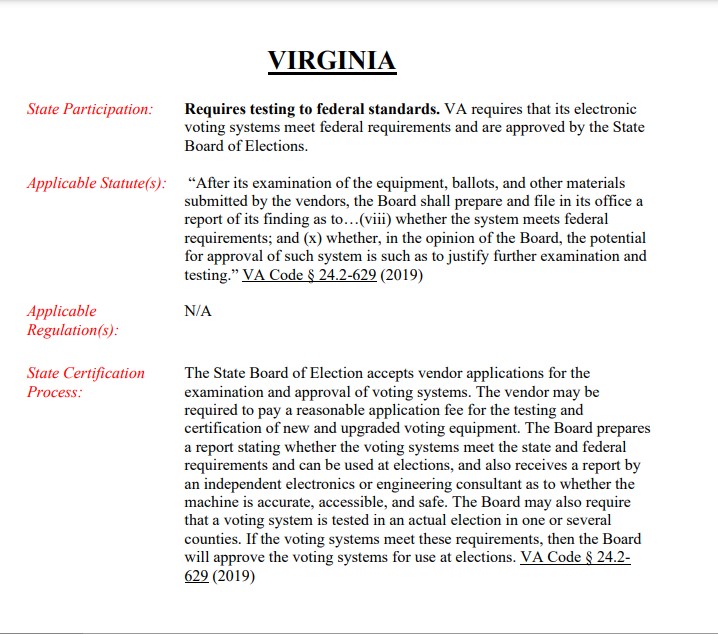As with any system like a car, a computer, a medical device, etc, there has to be management of the parts inside of it as well as the software. While this is rather dry, it is important to understand the federal and state process used for voting systems. When you do, you will see why there are controversies.
In 2002 the Help America Vote Act (HAVA) was passed by the US Congress in response to the Bush v Gore election ‘hanging chad’ issue in Florida. It established the Election Assistance Commission (EAC) to certify electronic voting systems for use in states. Each state has the option of complying with HAVA, and if they do comply they also select the way they comply. Virginia complies according to the following;

Ballot scanners – the device you place you ballot in to be tabulated.
Certification of the voting system also has to happen in Virginia after state testing and approval by the State Board of Elections (SBE). The Commonwealth’s State Board of Elections approves a standard for this voting system certification, and the version to which our current voting system is certified is the Virginia Voting System Certification Standard January 2020 Version 2.0, below.
Prince William County uses the Hart Verity 2.5.2 voting system to scan and tabulate ballots. This system is a modification of the Hart Verity 2.4 system, certified by the EAC on 2/21/2020 using the testing conducted by SLI Compliance. The EAC has a lot of detail on what the components of each part of the Hart Verity 2.4 system on their scope of certification document. Then the Hart Verity 2.5 was EAC certified on 9/9/20, with the relevant documents shown on the EAC site. Our county only uses the Scan, Central and Count software. After this, Virginia certified Hart Verity modifications to 2.5.1 and then 2.5.2 bring us to what we use today. However the state got their paperwork wrong, and the approval to 2.5.1 had a typo, according to the Virginia Department of Elections, and the document should have said 2.5.2. It is hard to tell what the change actually was. We have placed a Freedom of Information Request with the EAC to see if they approved these last two changes by ELECT. If they did not approve them, our system is no longer EAC certified but just state certified.
We were recently pointed to EAC’s map showing states and counties with EAC Certified Systems and we noticed Prince William, and other counites in Virginia using Hart, show the latest Hart certified system as 2.0, but we use 2.5.2. Hart 2.0 was EAC certified in 2016, after which Virginia possibly stopped notifying the EAC of any waivers, but the jury is still out on that. On the EAC map, RED means the county is using EAC certified systems, and white means non EAC certified. (The certification is questionable but that comes later.)
The EAC answer:
Hello,
Thank you for your inquiry. Within the Map of EAC Certified Voting System by County on the EAC website, the counties in red contain an EAC certified voting system and the counties in white do not contain an EAC certified system. This does not mean that they do not contain certified systems, as many of these states require a state certification and perform their own testing. The EAC does not track state certified systems, so they will not be represented within our map. Within our records, Verity 2.0 is the latest EAC certified system that was provided to Prince Williams County. It should be noted that the EAC relies on manufacturers, and occasionally jurisdictions, to provide information on what systems are being fielded.
Thank you kindly,
Jonathan Le | Senior Election Technology Specialist, Testing and Certification
U.S. Election Assistance Commission
633 3rd Street NW, Suite 200 | Washington, DC 20001
If you are interested in reading further on wireless communications testing Voting System EAC Certification and State Testing for Wireless Communications Summary of Colleague Input – Part 1 will get you started.
Pollbooks – These are the devices the election officers use to look up your registration to check you in as receiving a ballot.
Prince William County uses the pollbook system from Demtech Voting Systems. These are the tablets the election officers use to ‘check in’ voters after finding each person’s registration so that a ballot can be issued. This check in is what appears on the Virginia site to check your vote, and it means you received your ballot.
The EAC does not certify pollbooks for now, only the states do. Virginia’s State Board of Elections (SBE) approved a Virginia pollbook certification standard to which pollbooks are to be tested. One interesting thing about the DemTech certification in Virginia is that the Senior Policy Advisor to the State Board of Elections submitted working papers that show that one required test required for state certification was skipped. That is Test Case 0048, which is to test that the pollbook does not interfere with a ballot scanner. The only way this interference can happen is through wireless communications. Why was this test skipped?
Counties in Virginia that use DemTech have had many problems with them. Our working group wrote and submitted a Request for Technical Review that the county or state never answered. However since then, DemTech says they shipped new real time clocks for localities to install and that a software update would be coming. The new real time clocks did not fix the problems.
The main way you trace back through the development of the pollbooks we use now is to comb through the SBE meeting minutes. We won’t go there, but you could at virginia.townhall.gov The website Verified Voting has a nice and current database of pollbooks and ballot scanners in use across the country. Prince William County uses the DemTech ePolltab Advocate Precinct Other Virginia counties and their equipment are also listed. This includes the BPro KnowInk pollbook, in use in Fairfax and other counties, and owned by Dominion.
